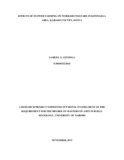| dc.description.abstract | The Kenyan flower industry is the 3rd largest flower supplier in the world and is among the
country's three top foreign exchange earners. Flori-cultural exports are Kenya's biggest export
earning, surpassing tourism as of the year 2008. The flower industry has a much higher
proportion of women than other sectors making worsens issues particularly sexual harassment
in the industry rampant (Muthoka, 2007). The negative impact that the global crash had on the
flower sector can be clearly catalogued. The profitability of the sector for established exporters
nose-dived following the financial downturn in the autumn of 2008 as purchasing power and,
thus, consumer demand for African flowers in Europe, Africa's biggest export market, quickly
dissipated. Flori-culture presents a threat to the workers of Kitengela area; if unaddressed, the
consequences are not only environmental, but also social and economic. Chapter 2 provided
literature review the effects of flower farming on the economic perspective, working conditions,
social interaction and on facilities and services as it reviews the theoretical framework,
discussion of the conceptual framework and the operational definitions. Agriculture continues to
be the most important economic sector in many sub-Saharan African countries (Raikes 1997)
and the regions relation to the world economy is persistently shaped by agro food commodities
and minerals (Gibbon and Ponte 2005). The chapter outlined the overall methodology that was
used in the study. This includes the study size and population. research design, sampling design,
data collection, data analysis and ethical issues. The study used descriptive research design since
the study gathered quantitative and qualitative data that describes the impacts of flower farming
on the livelihood of workers in Kitengela area. Chapter three outlined the overall methodology
that was used in the study. This includes the study size and population, research design, sampling
design, data collection, data analysis and ethical issues. Chapter four presents analysis of data
obtained from the respondents in the survey carried out in flower firms in Kitengela. Three firms
were visited 100 interviewee were interviewed from the three firms but only 95 respondents
filled the questionnaire which is 95% of the respondent. The results have been presented in
tables, figures and content delivery to highlight the major findings. Chapter five presents
summary of findings as discussed in chapter four and interpretations of the data analysis,
conclusions and recommendations based on the findings. | en_US |

